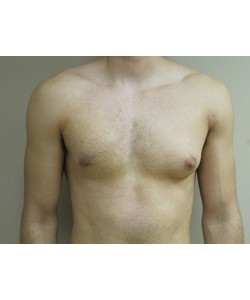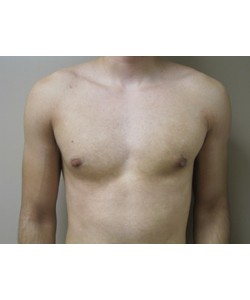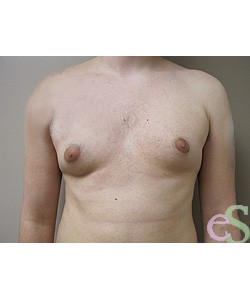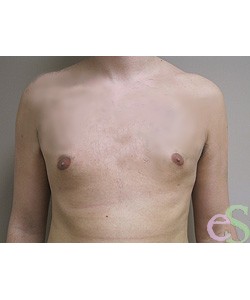Male Breast Reduction (Gynecomastia Treatment)
in San Antonio, TX
What Is Gynecomastia?
Gynecomastia, or male breast enlargement, occurs often in young teenagers and is due to changing levels of estrogen and testosterone. Gynecomastia frequently improves or resolves altogether as maturity sets in. In some instances, however, the amount of male breast enlargement is either significantly pronounced or so extremely persistent that plastic surgery is needed. Additionally, adult men can develop Gynecomastia later in life. Gynecomastia can lead to embarrassment and may result in loss of self-esteem and in social isolation.
Causes Of Gynecomastia
The causes of adult gynecomastia are not fully understood. Middle-aged and older men experience hormonal shifts, not unlike during puberty, and this could be behind adult gynecomastia. Breast enlargement is thought to be triggered by marijuana use, excessive alcohol consumption, heroin use, and taking certain herbal supplements that contain estrogen. In addition, some of the following medications can cause gynecomastia.
- Anti-anxiety drugs
- Antibiotics
- AIDS treatment drugs
- Heartburn treatment drugs
- Steriods
- Tricyclic antidepressants
Candidates for Male Breast Reduction Surgery
Whether or not your condition is right for surgical intervention involves ruling a few things out first. If your enlarged breasts are due to weight gain, the first step is to lose the weight and see if the condition persists. Heavy drinkers and marijuana users also aren’t candidates for surgery, as their breast enlargement comes from their lifestyle choices. If you are self-conscious about the appearance of your chest and find your social, athletic, or professional opportunities to be limited by gynecomastia, you may want to consider a male breast reduction.
Breast Reduction Before & After Photos
What Should I Expect at My Male Breast Reduction Consultation?
Dr. Schaffer can diagnose when gynecomastia is to blame. The key is to feel for a firm rubbery mass underneath the nipple area. The size of this mass is usually less than two inches in diameter and will often be sensitive when patients apply pressure. Before opting for surgery, Dr. Schaffer will likely begin treatment by prescribing medication that reduces the amount of estrogen the patient’s body is producing.
Gynecomastia Surgery
Several cosmetic male breast reduction procedures are available. These procedures include liposuction of excess breast tissue, surgical excision of excess breast tissue, or a combination of both. Sometimes, it is advantageous to remove the extra skin when the amount of skin is excessive. Additionally, Dr. Schaffer can remove excess skin to reduce the size of the nipples.
Additional procedures such as lateral chest wall liposuction or skin reduction may be helpful for you. At your thorough private confidential consultation, Dr. Schaffer will carefully consider your goals and the procedure that is best for you. Our office will treat you with sensitivity and respect when you visit. Your physical attributes such as the consistency of your breast tissue (firm versus soft), your amount of loose skin, and your nipple/areola size will influence which male breast reduction plastic surgical procedure is best for you.
What Our Patients Have to Say
“Dr. Schaffer performed my breast reduction surgery last month and I could not be happier! The staff is amazing and incredibly helpful. I had so many questions before and after my surgery and they never hesitated to give me an answer and give me help along the way. Dr. Schaffer is an incredible doctor and I am thrilled with my results. I could not have asked for a better experience. I’m currently a month post-op and have been healing very well. My scars are very minimal and are getting better each day. The pain was not nearly as bad as I thought it would be and I felt back to normal after about a week.” -Realself.com
Nonsurgical Gynecomastia Treatment
If your breast enlargement is due to an expansion of your glandular tissue, adjusting your hormone levels, especially estrogen, could correct the condition. But if this doesn’t alleviate the enlargement, surgery is the only remedy. However, if your breast enlargement is tied to medication use or weight gain, you have various non-surgical options to treat the condition.
Recovery From Male Breast Reduction Surgery
This is not an extensive surgery, and it doesn’t involve a difficult recovery. You will have some swelling and discomfort that can last up to two weeks, but this diminishes relatively quickly. Dr. Schaffer will require you to wear a compression shirt or vest to reduce swelling and to help your chest conform to its new contour. Most of our patients can resume normal activities within one week after surgery. Strenuous exercise, particularly any exercise that engages the chest muscles, will need to wait for about one month. Dr. Schaffer will discuss the details of your recovery with you during your consultation prior to surgery.
results of Gynecomastia Surgery
True gynecomastia, in contrast to enlarged breasts due to weight gain, is caused mainly by excess glandular tissue. This causes the protrusion of the nipple-areola complex. In reduction surgery, Dr. Schaffer removes the majority of the mammary gland, leaving enough to support the nipple-areola. With this tissue gone, the chances of recurrence are very low.
Can Gynecomastia Re-Occur?
Recurrence of gynecomastia is very rare after excision surgery. However, if your breast enlargement was due to the use of steroids, marijuana, or other medications, it is possible that your breasts may become enlarged again if usage continues.
Can I Get Rid of Gynecomastia by Doing Chest Exercises?
Breast tissue overgrowth in men has been misunderstood for far too long. While there is a weight component that can feed into enlarged male breasts, this does not mean that a man with true gynecomastia can hope to correct his breast size with diet and exercise. This myth leads many men down long and winding rabbit holes that leave them feeling frustrated or desperate. We should mention, also, that just like diet and exercise cannot help every man with gynecomastia, nor can the most well-marketed supplements!
If you noticed that we said “true gynecomastia,” you may be on to something. There is also a condition called pseudogynecomastia. This term refers to male breast enlargement that is solely related to obesity. What this means is that the breasts have enlarged primarily because of fat cells, not because of glandular tissue. That said, obesity may also have underpinnings of hormonal imbalance, which is one of the leading factors that contribute to true gynecomastia. If you are significantly overweight and have enlarged breasts, you might see some improvement in your shape once you reach your ideal weight. If you do not, you may be helped by the surgical removal of the breast gland.
Because there are multiple risk factors for gynecomastia, it’s to your advantage to consult with an experienced, board-certified surgeon about the most appropriate treatment.
Is Gynecomastia Male Breast Cancer?
Gynecomastia is the most common disorder to affect male breasts. The condition sometimes looks and feels like a lump or area of puffiness around the nipple and areola. More significant gynecomastia can look fuller and more like female breasts. The bad news is that gynecomastia can be difficult to reverse without a doctor’s care. The good news is that very few cases of gynecomastia are cancer. Most cases of male breast enlargement involve the completely benign overgrowth of glandular and fatty tissue resulting from hormonal imbalance or noncancerous medical conditions. While gynecomastia rarely turns out to be a sign of breast cancer, it is important to have any breast lumps checked by your doctor.
Can Gynecomastia Return Even if You Remove the Breast Gland?
Understanding the social and emotional toll that gynecomastia can have on your life, Dr. Schaffer will recommend treatment that is expected to achieve the best and longest-lasting results. It’s wise to ask your surgeon if your breasts could enlarge again after the treatment they’ve recommended! While it’s not expected, it can happen, and you need to know what circumstances may encourage the recurrence of your gynecomastia.
The chances of gynecomastia recurrence are very low. However, it’s important that you identify any factors that put you at risk. While some procedures do involve the removal of glandular tissue, this doesn’t usually include complete removal. Some of the glandular tissue may be left intact due to its role in filling out the male chest. With some of the breast gland present, there is the potential for recurrent enlargement caused by further hormonal imbalance, alcohol consumption, opioid use, marijuana use, and steroid use. If the factors that contributed to your gynecomastia are not eliminated, you have a higher risk of seeing subsequent breast enlargement at some point after your breast reduction surgery.
Schedule a Consultation
If you are interested in a male breast reduction or male breast enlargement, call 210-227-3223 to schedule a consultation with Dr. Eric Schaffer. Our practice serves San Antonio, Austin, and surrounding areas in TX.







